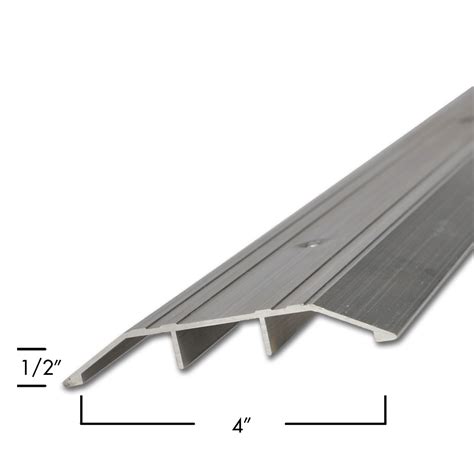Introduction
Accessibility is paramount in modern society, ensuring that individuals with disabilities have equal opportunities to participate in all aspects of life. One crucial element of accessibility is low profile threshold, which plays a vital role in eliminating barriers for wheelchair users, individuals with limited mobility, and anyone pushing heavy loads. This guide will provide a comprehensive overview of low profile threshold, its importance, key features, and applications.

Understanding Low Profile Threshold
A low profile threshold is a transition between two surfaces, such as a floor and a doorframe, that has a minimal height difference. This allows wheelchair users and individuals with difficulty navigating steps to move seamlessly through spaces without obstacles. Low profile thresholds are typically designed to be less than half an inch (12.7 millimeters) in height, making them virtually unnoticeable to most people.
Importance of Low Profile Thresholds
According to the World Health Organization (WHO), there are over 1 billion people with disabilities worldwide, many of whom face challenges with mobility. Low profile thresholds are essential for:
- Inclusion: Enabling wheelchair users and individuals with limited mobility to participate in all aspects of society, including education, employment, and social activities.
- Safety: Preventing tripping and falls for individuals with balance or vision impairments.
- Comfort: Providing a smooth transition between surfaces, reducing strain on joints and muscles.
- Efficiency: Facilitating quick and easy movement through spaces, saving time and effort for everyone.
Key Features of Low Profile Thresholds
Effective low profile thresholds exhibit several key features:
- Minimal height difference: Typically less than 0.5 inches (12.7 millimeters).
- Smooth transition: No abrupt changes in surface level, allowing for seamless movement.
- Durable materials: Constructed from materials that withstand heavy traffic and daily use.
- Aesthetically pleasing: Available in various colors and styles to complement any décor.
Applications of Low Profile Thresholds
Low profile thresholds are versatile and can be used in a wide range of applications, including:
- Buildings: Entrances, exits, and interior doorways.
- Transportation: Ramps, bus stops, and train stations.
- Public spaces: Sidewalks, parks, and museums.
- Healthcare facilities: Hospitals, clinics, and rehabilitation centers.
- Educational institutions: Schools, universities, and libraries.
Common Mistakes to Avoid
When installing and maintaining low profile thresholds, it’s important to avoid common mistakes:
- Improper installation: Incorrectly installed thresholds can create tripping hazards. Seek professional installation if necessary.
- Using inappropriate materials: Choose durable materials that can withstand heavy use and different weather conditions.
- Neglecting maintenance: Regular maintenance is crucial to ensure optimal performance and prevent damage.
- Ignoring aesthetic considerations: Select thresholds that complement the surrounding décor for a seamless look.
How to Choose the Right Low Profile Threshold
Selecting the appropriate low profile threshold depends on several factors:
- Purpose: Consider the intended use, such as indoor or outdoor applications, and the level of traffic expected.
- Size: Measure the width of the doorways or ramps where the threshold will be installed.
- Materials: Choose materials that meet the durability and aesthetic requirements.
- Budget: Determine the budget for the threshold and installation.
Step-by-Step Approach to Installing a Low Profile Threshold
- Prepare the area: Remove existing thresholds or trim and clean the surface.
- Apply adhesive: Apply a high-quality adhesive to the bottom of the threshold.
- Position and secure: Place the threshold in the desired location and use clamps or weights to secure it.
- Allow to cure: Give the adhesive time to cure fully, as per the manufacturer’s instructions.
- Finish: Check for any unevenness and apply sealant if necessary.
Frequently Asked Questions (FAQs)
-
What is the legal height requirement for low profile thresholds?
According to the Americans with Disabilities Act (ADA), low profile thresholds should be less than 0.5 inches (12.7 millimeters) in height. -
Are low profile thresholds expensive?
The cost of low profile thresholds varies depending on the materials and size required. However, the long-term benefits in terms of accessibility and safety make them a worthwhile investment. -
How often should low profile thresholds be maintained?
Regular maintenance is recommended to ensure optimum performance and prevent damage. Frequency may vary depending on traffic and weather conditions. -
Can low profile thresholds be installed in existing buildings?
Yes, low profile thresholds can often be retrofitted into existing buildings, eliminating the need for extensive renovations.
Conclusion
Low profile thresholds empower individuals with disabilities by removing physical barriers and creating accessible spaces for everyone. By understanding the importance, key features, and applications of low profile thresholds, we can contribute to a more inclusive and equitable society. This guide provides the knowledge and tools necessary to select and implement low profile thresholds effectively, ensuring a seamless and accessible environment for all.
